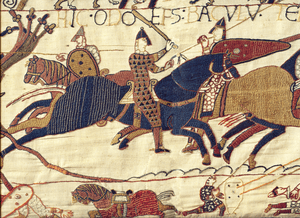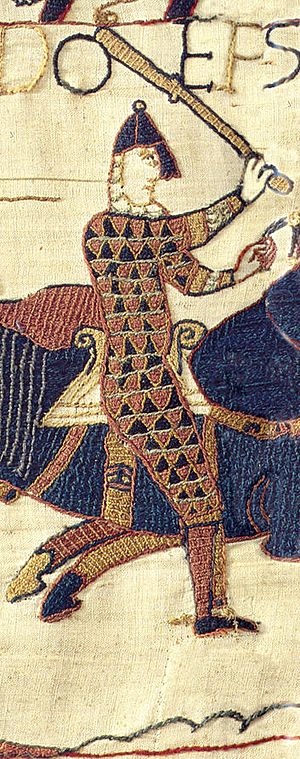Odo of Bayeux facts for kids
Odo of Bayeux (died 1097) was an important figure in England during the time of William the Conqueror. He was William's half-brother (they shared the same mother) and served as the Bishop of Bayeux. For a while, he was the second most powerful person in England, right after the King. He was also known as the Earl of Kent.
Contents
Odo's Early Life
Odo was the son of Herleva, William the Conqueror's mother, and Herluin de Conteville. His younger brother was Robert, Count of Mortain. Historians think Odo was born around 1035. When he was about 14 years old, in 1049, Duke William made him the bishop of Bayeux.
Odo and the Norman Conquest
Even though Odo was a Christian bishop, he was also known as a warrior and a leader. He helped pay for ships for the Norman invasion of England. He is one of the few people known to have fought at the famous Battle of Hastings in 1066.
The Bayeux Tapestry, a famous embroidered cloth that tells the story of the Norman Conquest, shows Odo at the battle. It suggests he didn't actually fight with a sword or shed blood. Instead, he encouraged the soldiers from behind. The words on the Tapestry above his image say: "Here Odo the Bishop holding a club strengthens the boys." This means he used a club to rally the troops. Some people think he couldn't use a sword because he was a bishop. However, clubs were common weapons, even used by leaders like Duke William himself. Odo had people with him, including a person who carried his special staff (crozier) and other helpers.

In 1067, Odo became the Earl of Kent. For several years, he was a trusted advisor to King William. Sometimes, when William was away in Normandy, Odo acted as a regent for England. This meant he ruled the country in the king's place. He also led royal armies against rebellions.
During this time, Odo gained a lot of land in England. He owned more land than anyone else except the king himself! He had land in 23 different counties, mostly in the south-east of England.
Challenges and Imprisonment
In 1076, Odo faced a public hearing at Penenden Heath in Kent. This meeting lasted three days. He was accused of misusing royal and church properties. After the hearing, he had to give back many of his lands and his wealth was reorganized.
In 1082, Odo suddenly lost the king's favor and was put in prison. He had planned a military trip to Italy. It's not completely clear why he did this. Some writers from later times said Odo wanted to become the pope. But the evidence from his own time is not clear. Whatever the reason, Odo stayed in prison for five years. The king took back his English lands and his title as Earl of Kent. However, he remained the Bishop of Bayeux.
When King William I was dying in 1087, his half-brother, Robert, Count of Mortain, convinced him to release Odo. After William's death, Odo returned to England. William's oldest son, Robert Curthose, became the duke of Normandy. His other son, William Rufus, became the King of England. Odo supported Robert Curthose's claim to the English throne.
This led to the Rebellion of 1088. The rebellion failed, and William Rufus allowed Odo to leave England. After this, Odo stayed in Normandy and continued to serve Robert.
Odo later joined the First Crusade. He began the journey to Palestine with Duke Robert. However, he died on the way in Palermo in early 1097. He was buried in Palermo Cathedral.
Odo in Movies and TV
Odo has been shown in a few TV productions:
- John Nettleton played him in the 1966 BBC TV play Conquest.
- Denis Lill played him in the 1990 TV drama Blood Royal: William the Conqueror.
See also
 In Spanish: Odón de Bayeux para niños
In Spanish: Odón de Bayeux para niños


